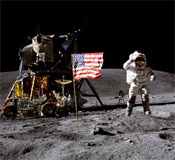United States National Aeronautics and Space Administration

United States National Aeronautics and Space Administration: Publications
Document Type
Article
Date of this Version
10-2011
Citation
Ophthalmology, Volume 118, Issue 10, October 2011, Pages 2058-2069; doi:10.1016/j.ophtha.2011.06.021
Abstract
Purpose: To describe the history, clinical findings, and possible etiologies of ophthalmic findings discovered in 7 astronauts after long-duration space flight, and document vision changes in approximately 300 additional astronauts.
Design: Retrospective, observational examination of ophthalmic findings in 7 astronauts and analysis of postflight questionnaires regarding in-flight vision changes in approximately 300 additional astronauts.
Participants: Seven astronauts with ophthalmic anomalies upon return from long-duration space missions to the International Space Station and 300 additional astronauts who completed postflight questionnaires regarding in-flight vision changes.
Methods: Before and after long-duration space flight, all 7 subjects underwent complete eye examinations, including cycloplegic and/or manifest refraction and fundus photography. Six underwent postmission optical coherence tomography (OCT) and magnetic resonance imaging (MRI); 4 had lumbar punctures (LP). Approximately 300 astronauts were queried regarding visual changes during space missions.
Main Outcome Measures: Refractive change, fundus photograph examination, retina OCT, orbital MRI, LP opening pressures, and examination of visual acuity data.
Results: After 6 months of space flight, 7 astronauts had ophthalmic findings, consisting of disc edema in 5, globe flattening in 5, choroidal folds in 5, cotton wool spots (CWS) in 3, nerve fiber layer thickening by OCT in 6, and decreased near vision in 6 astronauts. Five of 7 with near vision complaints had a hyperopic shift ≥±0.50 diopters (D) between pre/postmission spherical equivalent refraction in 1 or both eyes (range,+0.50 to +1.75 D). These 5 showed globe flattening on MRI. Lumbar punctures performed in the 4 with disc edema documented opening pressures of 22, 21, 28, and 28.5 cm H2O performed 60, 19, 12, and 57 days postmission, respectively. The 300 postflight questionnaires documented that approximately 29% and 60% of astronauts on short and long-duration missions, respectively, experienced a degradation in distant and near visual acuity. Some of these vision changes remain unresolved years after flight.
Conclusions: We hypothesize that the optic nerve and ocular changes we describe may result from cephalad fluid shifts brought about by prolonged microgravity exposure. The findings we report may represent parts of a spectrum of ocular and cerebral responses to extended microgravity exposure.
Financial Disclosure(s): The authors have no proprietary or commercial interest in any of the materials discussed in this article.

